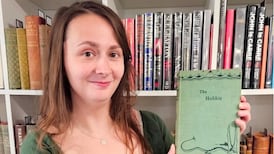When I began the first draft of the book that was to become My Buried Life, I knew the story would be set in Dublin and New York. Like most Irish people, New York fascinates me, and while I haven’t lived there, I’ve visited many times, and there’s something about the city that draws me in. Maybe it’s the familiarity of New York, its starring role in so many films and novels that I have loved that made it the right choice, but from the start, I wanted a piece of it in Eva’s story. It felt like the right city to place Eva, my narrator, who is displaced both at home in Dublin and in her adopted home.
My Buried Life is, at its core, a story about the search for a place to belong. Eva has packed her emotions tightly away, her personal tragedies colouring all her encounters and relationships. The house the novel is set in is the house my mother grew up in, on Sandford Road, in Ranelagh. The Ranelagh of my childhood, when my grandmother was alive and still living in the house, was a different place to the Ranelagh of today, and in a way I wanted to convey this through Eva’s sense of displacement upon her return to Dublin. She finds little that is familiar to her, now that the Celtic Tiger has taken over, and the area that she remembers has vanished under a wash of extensions, renovations and chi chi businesses.
The house itself has always remained with me: two storeys, Victorian redbrick, over a garden flat, and it is this structure that I was drawn to in the writing of the novel. Maude, Eva’s great aunt, lives her own, self-contained life in the garden flat, while Eva continues unabated above, yet there is a closeness between them that only a shared history can bring.
I also have a personal interest in writing about New York City. My mother’s grandmother, Kathleen, lived in Manhattan for over 50 years. Her husband bred prize Jersey cattle in Trenton, New Jersey, while Kathleen lived at 156 East 33rd Street. Having grown up on a large farm in Ballyfermot, she declared that rural living was no longer for her, so she settled into her own life in the city, her husband visiting at the weekends. Kathleen flourished in Manhattan. It suited her, and she had a thriving social life. A gifted seamstress, she made hats and wedding dresses under the moniker of Madame Kathleen. My mother still has one of her hats, a beautifully crafted chapeau with the Madame Kathleen label stitched in scarlet thread on the silk lining.
Her New York life reads like a particularly interesting list of achievements that most of us can only aspire to. Kathleen danced the Charleston in the twenties, patronised speakeasies during Prohibition, travelled Manhattan’s length on her scooter. She attended the opening of the Waldorf Astoria, when it moved from its original premises on the Empire State site, to where it now resides on Park Avenue. A liaison with Oscar of the Waldorf was hinted at, but never substantiated. She lived in New York through the Jazz Age, the Wall Street Crash and subsequent Depression, the second World War, and packed her bags for the last time during the Korean War. Maybe in her twilight years, the prospect of Ireland was a soothing alternative to living against the backdrop of such dramatic events.
Eva’s life in Manhattan is very different to my great grandmother’s. A successful academic at NYU, she lives in the East Village, a different existence to Kathleen’s life between Lexington and 3rd. But both were far from home, carving out a life for themselves, reinventing themselves away from the eyes of those who knew them in Ireland. Eva’s problems are not my great grandmother’s, and her self-destruction is her own. However, the bones of the two women’s stories have similar threads, and like Eva, Kathleen too eventually returned home, albeit after a much longer time abroad.
Kathleen moved back to Dublin in her seventies, a widow now, and was very happy with her decision. Her two adult daughters and her eight grandchildren all lived here, and she slotted back into life here with ease, something that amazes me still, given how long she had lived abroad. Eva does not find the transition as simple, and struggles with the push and pull of living at home and missing her life in Manhattan. Ultimately, it is Eva’s decision whether she will stay or go, and she is happy with the choice she makes. I think that for most emigrants there comes a moment of decision: to stay or to return home. Whatever the outcome is, I believe there will always be that ache for the other place, the place left behind. In this, Eva is like everyone who has packed their cases for that other life.
[ My Buried Life by Doreen FinnOpens in new window ]
Sarah Gilmartin’s review will be published in The Irish Times on Saturday, May 16th












